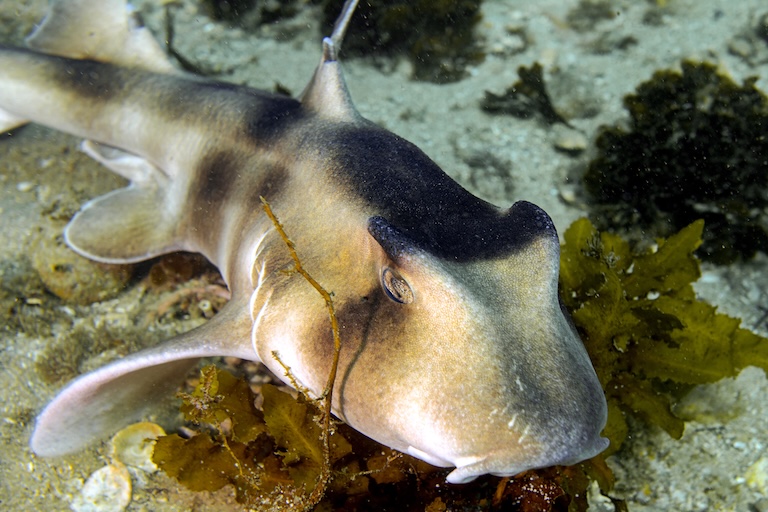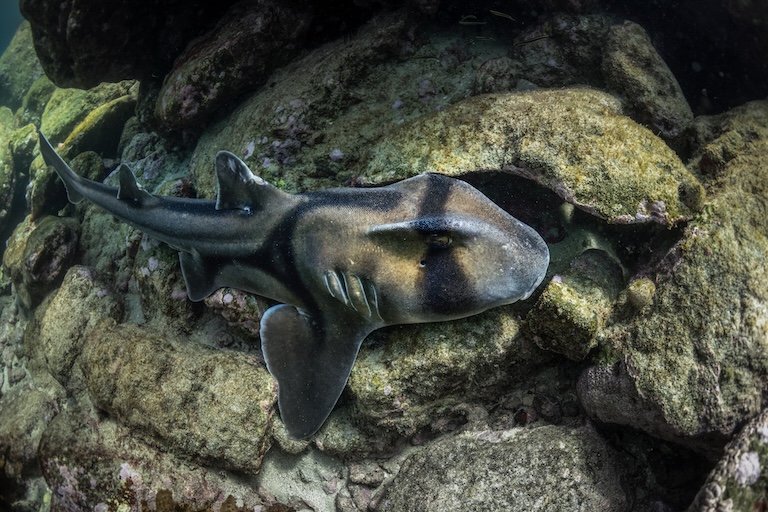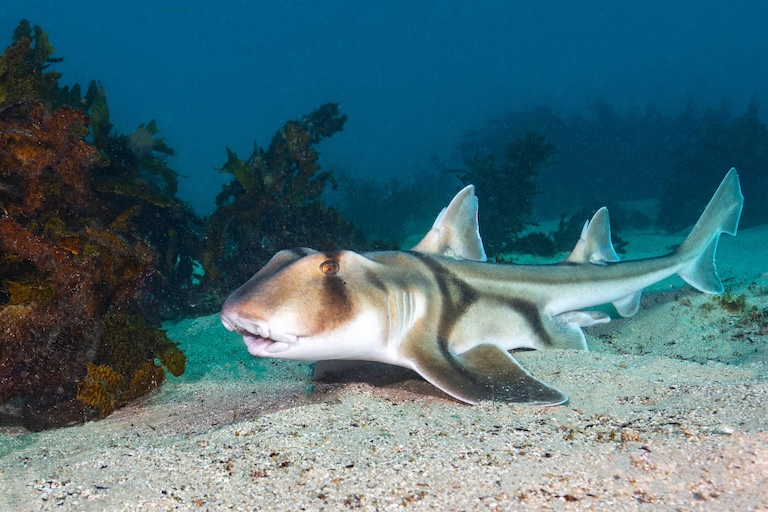Port Jackson Shark Profile
Looking a lot like a spacecraft from the Halo series, Port Jackson sharks are a very cool type of heterodont shark, known for surviving very well over the aeons, and still going strong to this day.
Port Jackson sharks are an old-school type of fish, predating most other lineages, but perhaps more impressively, still thriving in the face of overwhelming marine devastation.

Port Jackson Shark Facts Overview
| Habitat: | Shallow, rocky or grassy sea floor, |
| Location: | Southern Australia |
| Lifespan: | Up to 20 years |
| Size: | 1.65 metres (5.5 ft) long |
| Weight: | Up to 16kg (35.2 lb) |
| Colour: | Dappled browns and greys |
| Diet: | Molluscs, crustaceans, urchins and fish |
| Predators: | Larger sharks |
| Top Speed: | Slow |
| No. of Species: | 1 |
| Conservation Status: | Least Concern (IUCN) |
These little sharks are very good at what they do, and what they do is suck up shrimp, fish and urchins with their funny mouths and grind them into seafood paste.
Their eggs are pretty cool, too, and have evolved to drill themselves into cracks. Being small, they do need to hide out during the day and come out at night to feed.
When studied, they seem to have more character than is commonly expected from a shark, but they still haven’t quite figured out our music.
Interesting Port Jackson Shark Facts
1. They’re primitive!
This isn’t the insult that it might appear to be, especially among such an ancient lineage as the sharks.
Being primitive in this context means being part of a 175-million-year order of sharks called the Bullhead sharks, named for the prominent brow ridge that shows up in this species, one of only about ten in the only genus left in the order.
This makes the Port Jackson shark one of the only remnants of the prehistoric lineage of sharks that was once widespread over the Earth’s oceans, and they have absolutely nailed it.
These are the largest in the genus, are not critically endangered like a quarter of their kind found in coastal waters, and they don’t even get eaten by humans for the most part. This is a species of shark that found a strategy and stuck with it, and it’s working out well.

2. They’re spiky
Being very small sharks, they do need a certain level of defence against the larger and more bitey fish.
Port Jackson sharks have two dorsal fins with a spine at the tip. They don’t carry any venom in these spines but they are sharp enough to give predators second thoughts about biting down on one.
This might be where they got their nickname ‘horned sharks’ from, and these spines appear to dull with age and can be found washed up on beaches. 1
3. They lay crazy corkscrew eggs
Of course, the meaty version of an animal isn’t the only stage at which it can be eaten. Many creatures, including the PJ shark, lay eggs that are sought-after by predators, and these need to come with protections too.
One strategy is to just lay so many that the predators can’t eat them all, and another is to hide them very well. PJ sharks do a bit of both, and females will lay a pair of very strange-looking, spiral-shaped eggs every couple of weeks for around three months.
Embryos incubate inside these eggs for 10 to 11 months, and the shape of the egg functions as a screw, securing itself deeper between rock crevices as the ocean currents rock it back and forth.
After hatching, these sharks grow slowly, and the males mature between 8-10 years old, while the females take 11-14 years. That is if they make it to hatching. 89% of the eggs laid will be scoffed by predators. 2

4. They have super weird teeth
The Heterodontus part of this shark’s name refers to the way its teeth differ, unlike many sharks who have the same teeth all over their mouths (and would therefore be homodonts).
These teeth are one of the most recognisable parts of the animal and are a reflection of its diet. The front teeth are small and pointy like you’d expect shark teeth to be, and these are used for grabbing and holding onto slippery, soft things.
But at the back, the teeth change into wide, flat plates, ideal for crushing, which is what the shark foes when faced with hard-shelled animals like crabs and urchins.
Baby PJ’s have more spiky teeth and therefore eat more soft animals, and as they grow, the teeth and the diet shift to a more balanced range of both.
5. They can eat and breathe at the same time
Sharks can find it hard to pump water over their gills while their mouths are full, but the PJ has special gill slits that accommodate for this.
The first of the four slits is enlarged, and water can be pumped in over these while the mouth is busy, allowing the shark to maintain an oxygen supply without the need for buccal (mouth) pumping or ram ventilation (swimming with its mouth open).
This allows for more grinding time, which is great news for a crab eater, and also reduces the chance that valuable food will escape through the gill slits. 3
6. They’re nocturnal
Another way to avoid getting eaten as a small fish is to come out when all the dangerous giants have gone to sleep. PJ sharks are nocturnal, and their activity peaks just before midnight and dies down before sunrise.
In between they are well camouflaged among the rocky outcrops and sandy shallows of the reef, where they spend most of their time. Annual migrations between breeding and feeding zones occur, in which males will enter bays in advance of the females, who come in a bit later. The males will then leave the females to stick around the egg sites, perhaps as a way of increasing their protection. 4

7. They have J-shaped stomachs
Urchins come with a lot of wrapping, and this is all swallowed at first, but will then be regurgitated after the good stuff has passed through. Initial digestion occurs in a J-shaped stomach and is then moved into the gut, after which time the gastric jetsom can be released by turning this stomach inside out and pushing it out of the mouth.
These sharks have a very short intestine, but it’s spiralled, instead of tube-like to increase surface area. The majority of the rest of the shark’s body cavity is stuffed full of liver, which stores lots of lovely fat and helps the fish stay afloat in the absence of a swim bladder.
8. They have personalities
But there’s more to these sharks than a nice set of organs, they appear to have a decent capacity for learning and self-actualisation.
Young sharklets don’t seem to be very social, but this changes as they age, and the adults have what appear to be friends. There’s a natural variation in personality between the sharks, with some proving to be bolder than others, and some handling stressful situations in their own way.
A handful of tests suggest that they can learn to distinguish various stimuli and their associations, count, and learn by observing their peers.
One thing they can’t do, however, is distinguish between jazz and classical music, which not only emphasises how primitive they are but also makes you question where marine biologists are spending our money. 5 6C. Brown (2016), “Individual personality differences in Port Jackson sharks Heterodontus portusjacksoni”, Wiley Online Library.[/note]
Port Jackson Shark Fact-File Summary
Scientific Classification
| Kingdom: | Animalia |
| Phylum: | Chordata |
| Class: | Chondrichthyes |
| Order: | Heterodontiformes |
| Family: | Heterodontidae |
| Genus: | Heterodontus |
| Species: | Portusjacksoni |
Fact Sources & References
- Jace Hopper“Heterodontus portusjacksoni Bullhead”, Animal Diversity Web.
- Deep Marine Scenes (2022), “Facts: The Port Jackson Shark”, YouTube.
- Jace Hopper, “Heterodontus portusjacksoni Bullhead”, Animal Diversity Web.
- Tiffany S. Slater (2020), “Evolutionary relationships among bullhead sharks (Chondrichthyes, Heterodontiformes)”, Wiley Online Library.
- Catarina Vila Pouca (2018), “Food approach conditioning and discrimination learning using sound cues in benthic sharks”, Springer Link.
